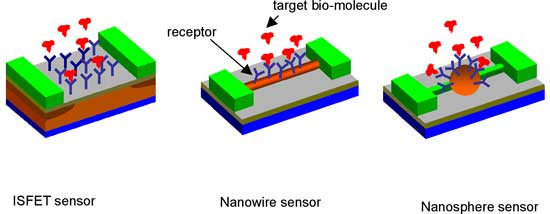| Posted: Jul 19, 2006 | |
Performance limits of nanobiosensors |
|
| (Nanowerk Spotlight) Nanoscale sensors based on silicon nanowires and carbon nanotubes are capable of detecting molecules at ultra low concentrations. The potential applications include early detection of cancer and fast sequencing of genome. However, for these applications, the time taken by the sensor to reach stable response is crucial. This time is dictated by the diffusion of molecules (e.g. cancer markers) through the solution and their subsequent capture at the sensor surface. Researchers at Purdue University show that this response is governed by the geometry of diffusion of the system and that nanobiosensors are capable of detecting bio-molecules at much lower concentration (up to 4-5 orders of magnitude) than the classical planar sensors (ISFETs or CHEMFETs). | |
| Based on electrostatics considerations, it is well known that nanowires are more sensitive to adsorbed charges e.g., DNA or protein, compared to ISFET or CHEMFET sensors. This classical view of nanosensor response, however, misses the kinetic part of the detection process, i.e., when a sensor is inserted in a solution of target biomolecules, the time to capture a certain number of biomolecules also depends on the dimensions of the sensor. | |
| Therefore, nanowire or nanosphere sensors, despite their superior electrostatic performance, will have to be designed carefully to achieve real time detection of target species at low concentrations. | |
| Professor Muhammad A. Alam and Pradeep R. Nair, both from the School of Electrical and Computer Engineering at Purdue University, explain to Nanowerk: "Once the molecule is captured on the sensor surface, its electrostatic response (how it modulates the current) is well known. But, for a given concentration of biomolecules and the measurement time window, the number of molecules that are captured on the sensor surface is still unknown. Our analysis provides a simple predictive relation to estimate the response time and provides important insights in the design and optimization of the sensor system for better performance." | |
| The two described their findings in a recent paper, first authored by Nair, titled "Performance limits of nanobiosensors", published in the June 9, 2006 issue of Applied Physics Letters. | |
 | |
| Schematic of nanosensors: the sensor surface is functionalized with specific receptors for the target bio-molecules. (Source: Pradeep Nair, Purdue University) | |
| In their paper, they develop a simple analytical model, based on reaction-diffusion theory, to predict the trade-off between average response (settling) time and minimum detectable concentration for nanobiosensors and nanochemical sensors. | |
| "Our results provide a benchmark to which experiments can be compared" Nair says. "It helps in better understanding of the exact physical processes that are involved in the adsorption of molecules on sensor surface and sensitivity limits of various types of sensors." | |
| Nanoscale sensors have many potential applications, in medical diagnosis as well as detecting the presence of harmful chemical species (e.g. nerve gas, carbon monoxide etc.). These results, along with the electrical design considerations, help in the synthesis of sensor arrays with improved performance. | |
| "In the field of nanobiosensors, the available experimental data are broadly scattered, the theoretical basis of the improved sensitivity is poorly understood, and the path to further optimization is ill-defined" says Alam. "In this research, we are developing a predictive theoretical framework for nano-bio sensors that will help with design and optimization of these systems." | |
| Describing his plans for future research activities, Alam states that they specifically plan to "(a) define the key functional variables and unifying principles for such sensors for rapid and simple interpretation of experimental data, (b) establish the limits to scalability and sensitivity of these devices, and (c) explore trade-off for sensitivity and response time for optimized performance. The simulation tools that we develop as a part of this research will be made available to the scientific community through nanoHUB." | |
 By
Michael
Berger
– Michael is author of three books by the Royal Society of Chemistry:
Nano-Society: Pushing the Boundaries of Technology,
Nanotechnology: The Future is Tiny, and
Nanoengineering: The Skills and Tools Making Technology Invisible
Copyright ©
Nanowerk LLC
By
Michael
Berger
– Michael is author of three books by the Royal Society of Chemistry:
Nano-Society: Pushing the Boundaries of Technology,
Nanotechnology: The Future is Tiny, and
Nanoengineering: The Skills and Tools Making Technology Invisible
Copyright ©
Nanowerk LLC
|
Become a Spotlight guest author! Join our large and growing group of guest contributors. Have you just published a scientific paper or have other exciting developments to share with the nanotechnology community? Here is how to publish on nanowerk.com.
